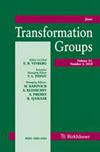在 $$\mathbb {P}^{1}$ 上数抛物线主 G 束带的无热点部分
IF 0.4
3区 数学
Q4 MATHEMATICS
引用次数: 0
摘要
让 G 是一个在 \(\mathbb {F}_q\) 上的分裂连通还原群,让 \(\mathbb {P}^1\) 是在\(\mathbb {F}_q\) 上的投影线。首先,我们给出了 G 的广义 Steinberg varieties 的 \(\mathbb {F}_{q}\)-rational point 的数量的明确公式。其次,对于 \(\mathbb {P}^1\) 上的每个主 G 束,我们给出了一个明确的公式来计算由在 0 和 \(\infty \) 处的抛物线结构以及相关邻接束的相容零点截面组成的三元组的数量。在\(GL_{n}\)的情况下,我们计算了这样的卷的生成函数,重新得出了梅利特的一个结果。本文章由计算机程序翻译,如有差异,请以英文原文为准。
Counting Parabolic Principal G-Bundles with Nilpotent Sections Over $$\mathbb {P}^{1}$$
Let G be a split connected reductive group over \(\mathbb {F}_q\) and let \(\mathbb {P}^1\) be the projective line over \(\mathbb {F}_q\). Firstly, we give an explicit formula for the number of \(\mathbb {F}_{q}\)-rational points of generalized Steinberg varieties of G. Secondly, for each principal G-bundle over \(\mathbb {P}^1\), we give an explicit formula counting the number of triples consisting of parabolic structures at 0 and \(\infty \) and a compatible nilpotent section of the associated adjoint bundle. In the case of \(GL_{n}\) we calculate a generating function of such volumes re-deriving a result of Mellit.
求助全文
通过发布文献求助,成功后即可免费获取论文全文。
去求助
来源期刊

Transformation Groups
数学-数学
CiteScore
1.60
自引率
0.00%
发文量
100
审稿时长
9 months
期刊介绍:
Transformation Groups will only accept research articles containing new results, complete Proofs, and an abstract. Topics include: Lie groups and Lie algebras; Lie transformation groups and holomorphic transformation groups; Algebraic groups; Invariant theory; Geometry and topology of homogeneous spaces; Discrete subgroups of Lie groups; Quantum groups and enveloping algebras; Group aspects of conformal field theory; Kac-Moody groups and algebras; Lie supergroups and superalgebras.
 求助内容:
求助内容: 应助结果提醒方式:
应助结果提醒方式:


